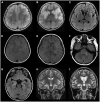The clinical relevance of anti-glutamic acid decarboxylase antibodies in children with encephalitis/encephalopathy
- PMID: 36817097
- PMCID: PMC9932768
- DOI: 10.3389/fnins.2022.1081580
The clinical relevance of anti-glutamic acid decarboxylase antibodies in children with encephalitis/encephalopathy
Abstract
Anti-glutamic acid decarboxylase (anti-GAD) antibodies are associated with different types of syndromes. However, few studies have investigated the correlation between anti-GAD antibody titers with clinical severity and outcomes in children with encephalitis/encephalopathy. In this single-center retrospective cohort study, we consecutively enrolled hospitalized children who had encephalitis and/or encephalopathy with positive anti-GAD antibodies in serum and/or cerebrospinal fluid (CSF) from February 2010 to October 2021. Thirty-seven patients were included and divided into high-titer and low-titer groups. The patients with high anti-GAD antibody titers were associated with initial symptoms of language difficulty and ataxia. The level of titers was not associated with severity or outcomes. Anti-GAD antibody titers decreased after immunotherapy, however, the clinical response to immunotherapy was variable. A transient elevation in anti-GAD antibody titers during immunotherapy was noted. Further studies are warranted to investigate the role of anti-GAD antibodies in the pathogenesis and immune mechanisms of encephalitis/encephalopathy.
Keywords: GAD; anti-glutamic acid decarboxylase antibody; antineuronal antibodies; ataxia; encephalitis; encephalopathy; immunotherapy.
Copyright © 2023 Hou, Liu, Kuo, Liu, Lin, Hsieh, Hung, Cheng, Su, Wang, Chou and Lin.
Conflict of interest statement
The authors declare that the research was conducted in the absence of any commercial or financial relationships that could be construed as a potential conflict of interest.
Figures



Similar articles
-
Anti-glutamic acid decarboxylase antibodies in the serum and cerebrospinal fluid of patients with stiff-person syndrome: correlation with clinical severity.Arch Neurol. 2004 Jun;61(6):902-4. doi: 10.1001/archneur.61.6.902. Arch Neurol. 2004. PMID: 15210528
-
Low-titer anti-GAD-antibody-positive cerebellar ataxia.Cerebellum. 2013 Apr;12(2):171-5. doi: 10.1007/s12311-012-0411-5. Cerebellum. 2013. PMID: 22923147
-
[A case of immune-mediated encephalopathy showing refractory epilepsy and extensive brain MRI lesions associated with anti-glutamic acid decarboxylase antibody].Rinsho Shinkeigaku. 2010 Feb;50(2):92-7. doi: 10.5692/clinicalneurol.50.92. Rinsho Shinkeigaku. 2010. PMID: 20196490 Review. Japanese.
-
Glutamic acid decarboxylase antibody-associated neurological syndromes: Clinical and antibody characteristics and therapy response.J Neurol Sci. 2023 Feb 15;445:120540. doi: 10.1016/j.jns.2022.120540. Epub 2022 Dec 29. J Neurol Sci. 2023. PMID: 36608627
-
GAD antibody-spectrum disorders: progress in clinical phenotypes, immunopathogenesis and therapeutic interventions.Ther Adv Neurol Disord. 2021 Mar 30;14:17562864211003486. doi: 10.1177/17562864211003486. eCollection 2021. Ther Adv Neurol Disord. 2021. PMID: 33854562 Free PMC article. Review.
Cited by
-
PARP inhibition preserves cone photoreceptors in rd2 retina.Acta Neuropathol Commun. 2025 Apr 1;13(1):68. doi: 10.1186/s40478-025-01982-5. Acta Neuropathol Commun. 2025. PMID: 40170065 Free PMC article.
-
Autistic traits modulate the influence of face masks on gaze perception.Sci Rep. 2023 Sep 10;13(1):14921. doi: 10.1038/s41598-023-41900-0. Sci Rep. 2023. PMID: 37691074 Free PMC article.
-
A Case of Type 2 Diabetes Mellitus Revealed Transient Positivity of Glutamic Acid Decarboxylase (GAD) Antibodies Following Immunoglobulin Administrations.Cureus. 2024 Aug 9;16(8):e66485. doi: 10.7759/cureus.66485. eCollection 2024 Aug. Cureus. 2024. PMID: 39247010 Free PMC article.
-
Comprehensive Venous Outflow Evaluation Predicts Stroke Outcome After Optimal Endovascular Ischemic Stroke Treatment.Transl Stroke Res. 2025 Aug 8. doi: 10.1007/s12975-025-01368-8. Online ahead of print. Transl Stroke Res. 2025. PMID: 40781220
-
Research Progress of Antioxidants in Oxidative Stress Therapy after Spinal Cord Injury.Neurochem Res. 2023 Dec;48(12):3473-3484. doi: 10.1007/s11064-023-03993-x. Epub 2023 Aug 1. Neurochem Res. 2023. PMID: 37526867 Review.
References
LinkOut - more resources
Full Text Sources

